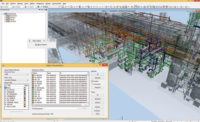After five years of PhD research and two years of software development, a start-up enterprise that applies parallel computing and artificial intelligence to construction planning and scheduling is ready to go to work.
The software is named Alice, which stands for “artificial intelligence construction engineering.” It comes from ALICE Technologies Inc., Stanford, Calif.
Inventor and CEO René Morkos says users start by uploading a 3D model and entering information about the construction method and resources available, such as the number of task-specific crews. The user applies inputs, which the developer calls “recipes,” that declare what each crew is expected to accomplish, rates and equipment, and how much time a standard task will take. The software analyzes the model to break the work into tasks, or a “to-do list.” Alice can be told to break the job into a set number of zones or sequence in a particular pattern.
When asked to develop the schedule, the software first determines which tasks have no predecessors and can be done first. It analyzes thousands of alternatives against spatial and other constraints to find the optimal order and then, having removed those items as constraints on the next run, optimizes again and again and again to build the schedule.
Learning as it goes, Alice can run millions of permutations in minutes and deliver the results in terms of time and cost. Then, the user can evaluate the options and tweak the parameters by changing, for example, the zones or adding more crews and then run it again.
“Alice understands calendars, weekends and that curing happens 24/7. It tries to schedule curing for weekends,” Morkos says.
“This technology could be the biggest paradigm shift in project planning since the evolution of 4D simulation tools,” says Dean Towl, director of project planning with Mortenson’s Denver Operating Group.
One of several construction technology leaders who have been watching and advising the developers of Alice, Towl has been testing it against traditionally built project schedules. One such schedule is for a large, complex hospital whose human-built critical-path-method schedule was the work of several months. “Within three or four days we had three million to four million options on the same project that we used to validate our CPM plan,” Towl says. “Alice came up with a very similar solution that was within about a week of our solution—it was actually slightly faster.”
Towl thinks the sweet spot for Alice will be for large, complex project planning and scheduling. But he says it also will take the right kind of team to use it well. “It takes a team that’s willing to think outside the box, check their egos at the door and let the computer do some thinking for them,” he says. “Where we saw the value was in having a very strong thought partner in the planning process.”
Another construction technologist who has followed Alice’s development is Nick Bokhoven, who is part of a 12-person leadership team in the San Diego office of DPR Construction. The company recently applied Alice to the schedule for a 1,200-car parking structure that was already under construction.
“We’re pretty confident that it could have saved us two weeks on that schedule if we had engaged Alice prior to mobilization. It was really intriguing. We could have come out of the ground differently with the foundation walls and the deck sequence,” Bokhoven observed.
He says DPR has just signed a one-year contract to try Alice out on real projects in DPR offices in five U.S. regions. “The goal is to have [Morkos] and his team visit those regions and each pick a demonstration project to try and prove its value. It has generated substantial interest in the organization.”
Morkos says the creation of Alice took about 35,000 hours of sequential problem-solving, but suddenly, about five months ago, “everything clicked. It worked. Alice really ‘gets’ construction,” he says.
“I consider it to be 4D on steroids,” says Towl. “It takes out the time we spend during project planning to develop iterations and options and uses that time on validating the options the computer has come up with.”





Post a comment to this article
Report Abusive Comment